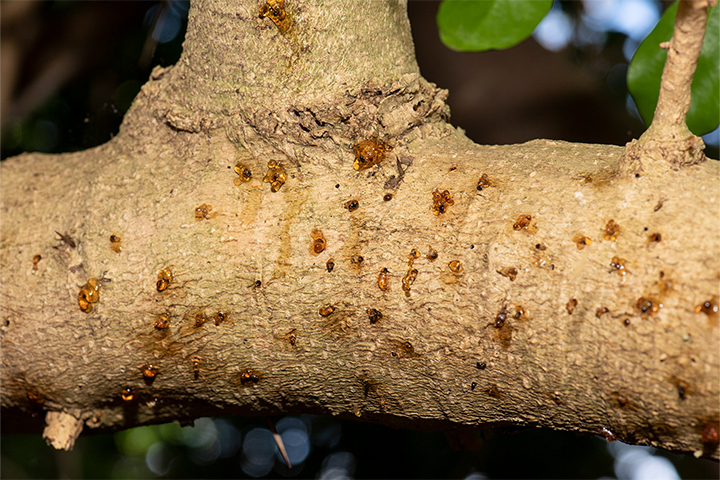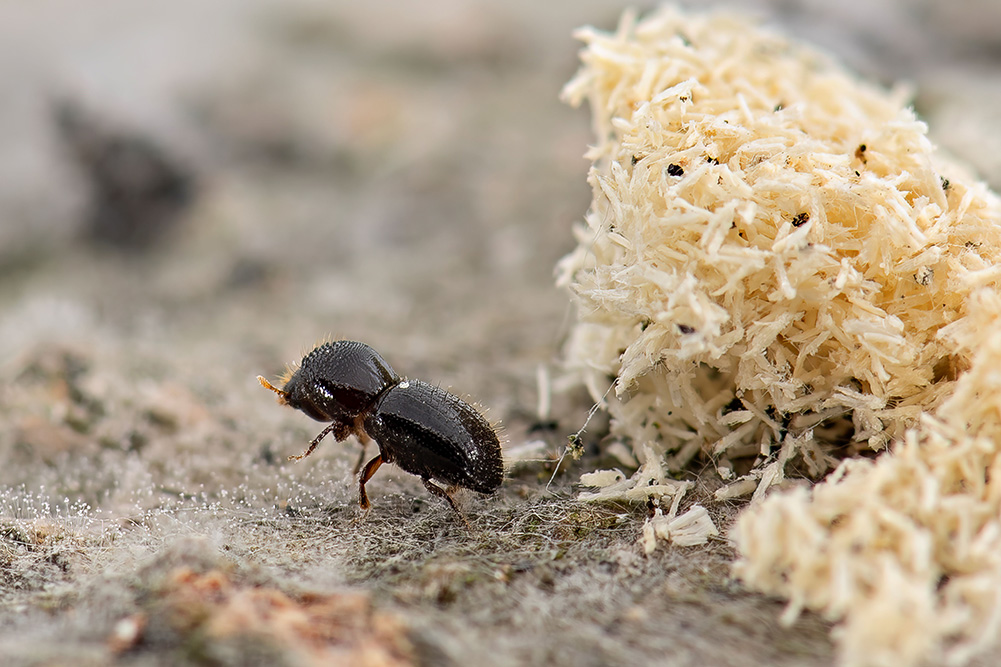Polyphagous Shot-hole Borer
The Shire of Serpentine Jarrahdale is working with the Department of Primary Industries and Regional Development (DPIRD) to help stop the spread of the invasive pest Polyphagous shot-hole borer (PSHB).
Establishment of this pest in WA would have a significant impact on our urban tree canopy and pose a threat to our agricultural industry. The PSHB eradication program is a nationally coordinated and funded response led by DPIRD, since the detection in 2021.
What is a Polyphagous Shot-hole Borer?
Polyphagous shot-hole borer (PSHB, Euwallacea fornicatus) is a small beetle native to Southeast Asia that tunnels into the trunks, stems and branches of trees and plants. It also has a symbiotic relationship with a Fusarium fungus. It cultivates this fungus inside of plants as a food source for themselves and their larvae.
In susceptible trees, the fungus kills the tree by restricting or preventing the movement of water and nutrients within the tree. This causes symptoms such as Fusarium dieback and eventually tree death. The beetle also creates tunnels, known as galleries, which impacts the structural integrity of the tree.


What is being done to help?
A Quarantine Area (QA) restricting the movement of wood, green waste, mulch, live plants and plant material has been put in place to help stop the spread of PSHB.
The QA was extended on 14 November 2025 to cover the entire Perth Metropolitan area, extending across 30 local government areas. This is an updated QA since the last extension in late 2024. The QA encompasses two zones:
- Management Zone covers an area with high numbers of infested trees and has intensive control activities, such as tree removal. This zone has more restrictions on the movement of high-risk materials. Darling Downs, Oakford, Oldbury, Byford, Cardup, Whitby, Karrakup and parts of Mundijong are in this zone.
- Containment Zone covers an area with fewer to no infested trees and has heightened surveillance underway to identify and control any new infestations discovered. This zone will help create a buffer between areas of high infestations and the rest of WA to further protect our flora. Parts of Mundijong, Mardella, Hopeland, Serpentine, Jarrahdale and Keysbrook are in this zone.
What does this mean for Shire residents and businesses?
For residents and businesses in the Management Zone:
- You cannot move plant materials with a stem greater than 2cm in diameter outside of the Management Zone, including into the Containment Zone.
- You cannot move untreated or unseasoned wood outside the Management Zone, including into the Containment Zone, unless chipped to pieces that are 2.5 cm or less in diameter.
- You may freely move treated or seasoned wood or wood products to be used for construction, fencing, furniture, packaging or pallets.
- You must ensure that any machinery used to process wood and plant material is cleaned before it can leave the Management Zone, including into the Containment Zone.
- You may move all material within the Management Zone.
For residents and businesses in the Containment Zone:
- You cannot move plant materials, with a stem greater than 2cm in diameter outside the Quarantine Area (to beyond the Management and Containment Zone).
- You cannot move untreated or unseasoned wood outside the Quarantine Area (to beyond the Management and Containment Zone), unless chipped to pieces that are 2.5 cm or less in diameter.
- You must ensure that any machinery used to process wood and plant material is cleaned before it can leave the Quarantine Area (to beyond the Management and Containment Zone).
- You can move wood or plant materials, including living plants, into the Management Zone from the Containment Zone or within the Containment Zone.
- You may freely move treated or seasoned wood or wood products to be used for construction, fencing, furniture, packaging or pallets.
Refer to DPIRD Quarantine Map Suburb Location to identify which Zone your property is in and the Frequently Asked Questions for further clarification. A permit from DPIRD, may be needed if you cannot meet the conditions of the QA notice.
What plants are affected?
This beetle is highly invasive and attacks a wide range of plant species. The plants affected include native and non-native species.
The plant species list is ever evolving, but species that have been found to be heavily impacted include:
- Box elder maple (Acer negundo)
- Coral tree (Erythrina)
- Black locust (Robinia)
- Fig (Ficus)
- Plane tree (Platanus)
- Poinciana (Delonix)
- Chinese hibiscus (Hibiscus rosa-sinensis)
- Mulberry (Morus)
Restrictions apply to wood, green waste, plant material and impacted machinery.
- Wood means wood that is not treated. This includes firewood that has been seasoned for less than 6 months.
- Green waste includes cut branches or prunings, bark, plant mulch or wood chips. It does not include lawn clippings.
- Plants means any plant or plant part (including plant cutting) with stems greater than 2 cm in diameter.
- Machinery means any vehicle, equipment or other mechanical apparatus of any kind that has been used in relation to arboriculture, gardening, mulching, wood chipping or handling of any other wood.
A comprehensive list can be found at DPIRD - PSHB - WA Host Plant List.


What is not affected?
PSHB does not affect grass, lawn clippings, leaf matter or fruits and vegetables so can be disposed of as normal.
Treated timber or wood products used for construction, fencing or similar are not considered material at risk of PSHB.
How is PSHB controlled?
There is currently no effective chemical control of the borer. The most successful method is to remove the infected limbs and or tree and chip the wood.
Residents are asked not to treat suspected trees as this could lead to further damage to the tree. The removal of an infested tree will only come via DPIRD following the issue of a Pest Control Notice.
What is the Shire doing?
The Shire is collaborating with DPIRD to raise awareness, along with training staff to recognise the signs of PSHB. We're also working with DPIRD to manage any impacted trees on Shire property.
What can you do?
- Help keep your trees healthy.
- Follow the Quarantine guidelines.
- Download the MyPestGuide Reporter App, keep an eye on your trees and report any sightings of PSHB via either the app, by calling 08 9368 3080 or emailing padis@dpird.wa.gov.au.
- If you need to move the impacted trees, please schedule an inspection by emailing pshb@dpird.wa.gov.au with your name and contact details, your business name (if applicable), details of the material you wish to move, locations of where you wish to move the material to and form and the date you wish to move the material.
- If unintentional or inappropriate disposal of PSHB infected trees and material occurs, or is suspected to have occurred, please immediately contact the Pest and Disease Information Service (PaDIS) via email padis@dpird.wa.gov.au or phone 9368 3080.
- You can apply to the WA Tree Recovery Program if you are impacted by the PSHB. Under this program, eligible residents can claim up to $150 for every tree removed under DPIRD authorisation as a result of PSHB.
Further information contact DPIRD on 08 9368 3080 or padis@dpird.wa.gov.au. You can also visit the Department of Primary Industries and Regional Development website.